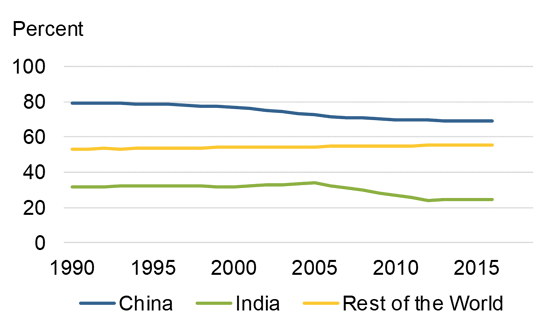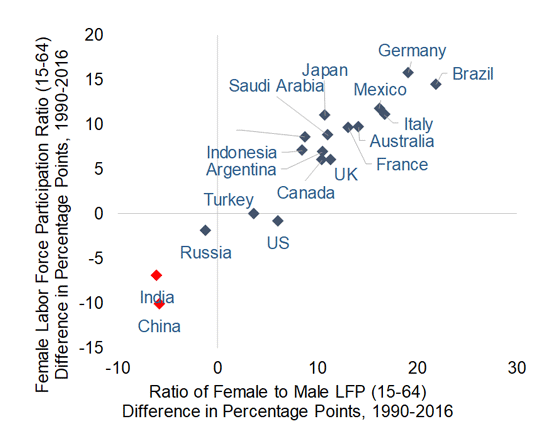In most countries, women’s participation in the labor force has steadily improved over time. However, in the world’s two most populous economies—China and India—female labor force participation rates have been trending down during the past several decades. This blog takes a close look at factors underlying the lower level of female labor force participation in China and India, the potential impacts of this trend on economic performance, and public policy options that can help slow or reverse the trend.
China and India are Outliers in Female Labor Force Participation
According to the International Labor Organization’s ILOStat database, 134 out of a sample of 188 economies have witnessed an improvement in working age (15-64) female labor participation rates (FLPR) between 1990 and 2016. The improvement was fairly substantial: for these 134 economies, FLPRs increased by an average of 9.0 percentage points during this period. But when calculated on an aggregate level, the world’s FLPR trend paints a different picture. The ILO estimates that 53.1 percent of the working age female population worldwide were in the workforce in 2016, a 2.8 percentage point decline from 1990. What gives?
These divergent messages are largely a result of developments in the world’s two most populous economies—China and India.1 From 1990 to 2016, FLPR for China and India declined by 10.1 and 6.9 percentage points, respectively, while the rest of the world (in aggregate) saw FLPR rise by 2.7 percentage points (Figure 1).
Female Labor Force Participation Rate Trend (18-64)

Falling FLPRs in both economies reflect a broader phenomenon of labor force participation rates declining across both men and women since 1990. But compared to male labor force participation rates, FLPR have fallen much faster, leading to a widening of the gender gap. Indeed, the ratio of working age female to male labor force participation rates for both China and India are at their lowest levels since 1990, leaving the two economies as outliers among G20 countries (Figure 2). Over time, the attrition of women in the labor force has led to a significant gap in nominal terms: in order to restore the female-to-male ratios to their 1990 levels, China and India together would need to add 47 million women workers, equal to an 11 percent expansion of their current female labor force.
China and India Saw Reduced Female Labor Force Participation Since 1990

While these headline trends appear similar in both China and India, the underlying drivers of falling female labor force participation vary distinctly based on demographics, economic structures, and social contexts.
The China Story
Notwithstanding the recent decline in China’s FLPR, China boasts one of the higher levels of female labor force participation in the world. Women in China’s workforce make a sizable contribution to the domestic economy; in a recent study, McKinsey Global Institute estimated that Chinese women’s contribution to China’s GDP was 41 percent, the highest in the Asia Pacific region.
Underpinning the decline in women’s labor force participation is a confluence of factors. In part, it reflects structural changes in the Chinese economy. As household income grows alongside the broader economic expansion, more households can afford to have only one wage earner. Meanwhile, households now have more options for social benefits outside of the traditional employer-provided ones thanks to pension and healthcare reforms. As a result, households are not as reliant on full-time jobs as before, giving men and women alike the flexibility to opt out of the labor force.
While rising incomes and benefit options represent positive drivers of falling female participation, cultural barriers remain a persistent challenge. In particular, plenty of anecdotal evidence has suggested that hiring bias against women is on the rise. In this area, unintended consequences of public policy are partly to blame. Labor and employment laws have been updated in recent years to take, among other things, the much desired step to ensure protection of pregnant women’s rights. Adversely, however, these changes led to hiring practices that disadvantaged female applicants, as employers perceived potential future pregnancy as raising the costs of employing women.
Looking ahead, China’s aging population and related policy changes will likely pose additional challenges. To offset the demographic strain, China ended its “one-child” policy in 2016. Fertility rates have yet to show a meaningful increase, but should more households decide to have two or more kids, it is likely that more women will at least temporarily leave the labor force. Hiring biases could deteriorate further if more women choose to have more than one child. Furthermore, inadequate childcare framework in China’s social safety system could make it more difficult for mothers to return to work if fertility rates do in fact increase.
The India Story
India lies on the opposite end of the spectrum when it comes to female participation in the labor force. Its FLPR was only 31.8 percent in 1990, but had fallen even lower to 24.9 percent by 2016, leaving India ranked among the lowest in the world.
India has made steady progress in urbanization over the past three decades. But some experts have pointed out that given the disparity in sector employment by gender, rapid urbanization has actually contributed to a growing discrepancy between male and female labor participation. Traditionally, a large share of female workers—76.1 percent in 1991 compared to 58.6 percent for men—were in the agricultural sector. As agriculture’s share in total employment fell from 63.1 in 1991 to 45.1 percent in 2016, traditional opportunities for female rural workers dwindled. Compounding the challenge, safety concerns and the lack of transportation infrastructure make it difficult for women to join the urban labor force. Whereas India has added nearly 150 million non-agricultural jobs between 1991 and 2016, male workers accounted for 83 percent of the new jobs in industry and services sectors.
Educational attainment among women—though on the rise—may actually be hurting labor participation. According to World Bank data, 76 percent of Indian women were enrolled in secondary school in 2016, up from 27 percent in 1989. However, progress in female educational attainment does not necessarily translate to employment gains. One research paper observed a U-shaped relationship between education and FLPR. The authors found that Indian women with very low levels of education were actually more likely to be in the labor force than women with some secondary education. In contrast, higher attainment levels are universally associated with higher employment outcomes for men. These findings point to a mismatch between jobs and skillsets of Indian women, which appears to be more significant in urban areas.
What Can Public Policy Do?
The underrepresentation of women in the labor force has considerable economic consequences. The McKinsey Global Institute estimates that advancing women’s equality could lead to a $12 trillion increase in global output by 2025. Increasing labor-force participation by women would drive more than half of the economic impact, while other potential gains would arise from increasing the number of women in full-time jobs and higher productivity industries. The study also found that if China and India can match the gender parity of their fastest improving neighbors, the two countries could add a total of $3.4 trillion to global GDP by 2025.
Public policy is critical for such transitions to take place. In China’s case, there is some low hanging fruit. For instance, China has long mandated different retirement ages for men and women. Many argue that abolishing early retirement requirements for women workers will help improve female labor force participation. But to slow or even reverse the downward trend in FLPR requires coordinated efforts among government, employers, and society. Progress needs to be made, among many other things, on improving the social safety net to reduce the burdens of domestic work, child care, and senior care that often fall on women. In addition, cultural shifts that entail developing a mindset to ensure level playing fields for male and female workers will also be critical. In this regard, China’s recent measures to reduce gender discrimination in hiring, is a welcome, albeit small step.
For India, the challenge is profound. The current low level of female participation in the workforce has prevented women from sharing the benefit and economic opportunities associated with the country’s rapid growth. Encouragingly, the government has implemented various programs to confront the challenge. The Skill India Mission, for example, provides vocational training programs tailored to women. The international community supported such endeavors: the World Bank has invested over $3 billion to improve skills and market access for poor women in rural India. But more needs to be done. Infrastructure needs include improving access and safety of transportation. Labor market reforms should focus on bridging job-skill mismatches. At the highest level, social norms need to evolve to support communities that are inclusive and safe to men and women alike.
1. A few other smaller economies experienced more dramatic reduction in FLPR, but China and India had a larger impact due to the size of their population and economy.
The views expressed here do not necessarily reflect the views of the management of the Federal Reserve Bank of San Francisco or of the Board of Governors of the Federal Reserve System.
